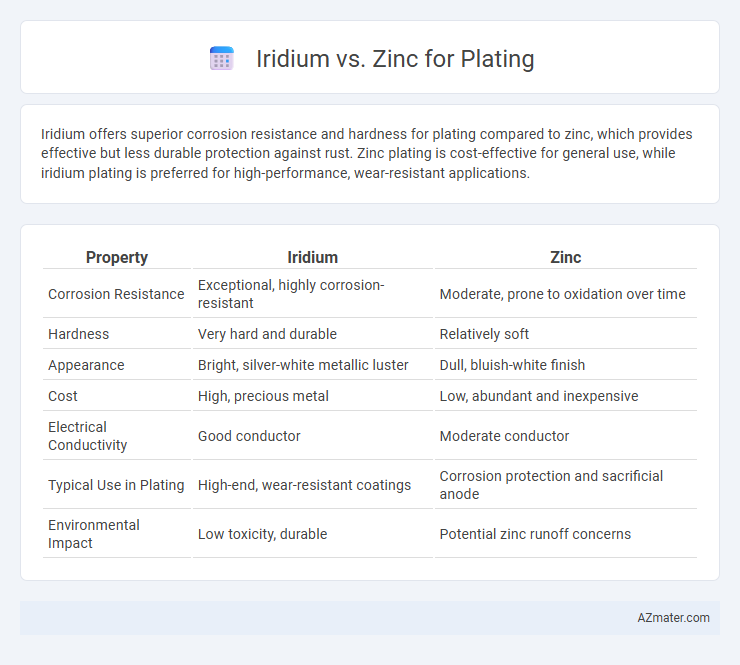Iridium offers superior corrosion resistance and hardness for plating compared to zinc, which provides effective but less durable protection against rust. Zinc plating is cost-effective for general use, while iridium plating is preferred for high-performance, wear-resistant applications.
Table of Comparison
| Property | Iridium | Zinc |
|---|---|---|
| Corrosion Resistance | Exceptional, highly corrosion-resistant | Moderate, prone to oxidation over time |
| Hardness | Very hard and durable | Relatively soft |
| Appearance | Bright, silver-white metallic luster | Dull, bluish-white finish |
| Cost | High, precious metal | Low, abundant and inexpensive |
| Electrical Conductivity | Good conductor | Moderate conductor |
| Typical Use in Plating | High-end, wear-resistant coatings | Corrosion protection and sacrificial anode |
| Environmental Impact | Low toxicity, durable | Potential zinc runoff concerns |
Introduction to Metal Plating Technologies
Iridium and zinc plating are distinct metal plating technologies used to enhance surface properties such as corrosion resistance and conductivity. Iridium plating offers exceptional hardness, chemical stability, and resistance to wear, making it ideal for high-performance applications like electronics and aerospace components. Zinc plating provides effective corrosion protection and is more cost-efficient, commonly applied in automotive and construction industries to prevent rust on steel parts.
Overview of Iridium and Zinc as Plating Materials
Iridium offers exceptional corrosion resistance and hardness, making it ideal for high-performance plating applications requiring durability and chemical stability. Zinc plating provides excellent sacrificial protection against rust, commonly used for steel components to prevent oxidation and extend service life. Both metals serve distinct purposes: iridium excels in premium coatings with extreme wear resistance, while zinc is preferred for cost-effective corrosion protection in industrial settings.
Chemical Properties: Iridium vs Zinc
Iridium exhibits exceptional chemical resistance and corrosion stability due to its inert nature and high melting point of 2,446degC, making it ideal for plating applications requiring durability in harsh environments. Zinc is more chemically reactive, prone to oxidation, and has a melting point of 419.5degC, which provides sacrificial protection through galvanization but offers less long-term corrosion resistance compared to iridium. The nobility and passivation behavior of iridium allow it to maintain surface integrity without significant degradation, whereas zinc forms a protective oxide layer that can deteriorate over time under aggressive conditions.
Corrosion Resistance Comparison
Iridium plating offers exceptional corrosion resistance due to its high chemical stability and inertness, making it ideal for harsh environments and applications requiring long-term durability. Zinc plating provides moderate corrosion protection, primarily through sacrificial galvanic action, which corrodes preferentially to the base metal but is less effective in highly corrosive or acidic conditions. Iridium's superior resistance to oxidation and chemical attack significantly outperforms zinc, making it the preferred choice for critical applications exposed to aggressive corrosion factors.
Conductivity and Performance in Applications
Iridium offers superior corrosion resistance and high conductivity, making it ideal for extreme environments and precision electronic components. Zinc provides good conductivity at a lower cost, suitable for general corrosion protection and electrical contacts in less demanding applications. Iridium's durability and stable conductive performance outperform zinc in high-temperature and high-wear conditions.
Cost Analysis: Iridium vs Zinc Plating
Iridium plating is significantly more expensive than zinc plating due to the rarity and high refining costs of iridium, with iridium priced around $6,000 per ounce compared to zinc at under $1 per pound. Zinc plating offers a cost-effective solution for corrosion resistance in large-scale applications, making it ideal for industries prioritizing budget efficiency. While iridium plating delivers superior hardness and corrosion protection, its high cost limits its use to specialized, high-performance components.
Environmental Impact and Safety Considerations
Iridium plating offers superior corrosion resistance and durability with minimal environmental pollution due to its inertness and resistance to chemical leaching, making it safer for long-term applications. Zinc plating, while effective for rust prevention, involves the use of toxic chemicals and generates hazardous waste that requires careful disposal to minimize soil and water contamination. Choosing iridium reduces ecological risks and health hazards associated with zinc's chemical byproducts and heavy metal pollution.
Common Industrial Uses and Suitability
Iridium plating is primarily used in high-performance electronics and chemical equipment due to its exceptional corrosion resistance and electrical conductivity, making it suitable for components exposed to harsh environments. Zinc plating is widely applied in automotive and construction industries for corrosion protection of steel parts, offering cost-effective, sacrificial protection against rust. The choice between iridium and zinc plating depends on the need for durability and resistance to extreme conditions versus economical, large-scale corrosion prevention.
Plating Process Differences: Iridium vs Zinc
Iridium plating involves a complex electroplating process using iridium salts and requires high-temperature conditions to achieve a thin, corrosion-resistant, and wear-resistant finish primarily used in electronics and jewelry. Zinc plating utilizes a simpler, aqueous zinc salt solution at lower temperatures, providing sacrificial protection against rust mainly for automotive and industrial steel components. The distinct chemical stability and deposition methods result in iridium producing a more durable, high-value coating, while zinc offers cost-effective corrosion resistance with easier application and thicker deposits.
Choosing the Right Plating Material: Key Factors
Iridium and zinc plating differ significantly in corrosion resistance and durability, with iridium offering exceptional hardness and chemical stability ideal for high-performance applications. Zinc plating provides cost-effective corrosion protection, especially against rust in automotive and construction industries, making it suitable for less demanding environments. Selecting the right plating material depends on factors like environmental exposure, mechanical stress, cost constraints, and desired lifespan, ensuring optimal performance and longevity.

Infographic: Iridium vs Zinc for Plating
 azmater.com
azmater.com